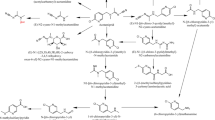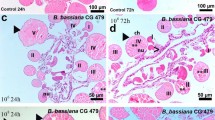Abstract
The largest part of the life cycle of Gordiida, known as horsehair worms, occurs in aquatic environments usually affected by agricultural activities. The free-living adults reproduce in freshwater environments, where preparasitic larvae undergo development. Since malathion is an insecticide used in the distribution area of Chordodes nobilii, the aim of this study is to evaluate the effect of malathion concentrations which might be expected in the environment on preparasitic stages of this species. The embryonic development and the viability of larvae were analyzed after a short-term exposure to malathion concentrations ranging between 36 and 220 μg a.i./l. Embryo development was inhibited at 220 μg a.i./l and the infective capacity of larvae derived from malathion-exposed eggs was significantly decreased starting from the lowest concentration. Larvae developed from malathion-exposed eggs exhibited malformations. Directly exposed larvae also showed decreased infectivity since the lowest assayed concentration. Our results indicate that a short-term exposure to malathion at levels potentially present in the surface water in environments inhabited by Chordodes nobilii affects significantly its preparasitic stages and the infective capacity of parasitic larvae.




Similar content being viewed by others
References
Achiorno C, de Villalobos C, Ferrari L (2008) Toxicity of the herbicide glyphosate to Chordodes nobilii (Gordiida, Nematomorpha). Chem (Kyoto) 71:1816–1822
Aduriz MA, Gargano AO, Chimeno P, Saldungaray MC, Conti VP (2003) Caracterización de los agrosistemas predominantes de la cuenca alta del río Sauce Grande RIA, 32(3):3–26 INTA, Argentina, ISSN 0325–8718
ATSDR (2003) Agency for Toxic Substances & Disease Registry, Public Health Service, Toxicological profile for malathion. US Department of Health and Human Services. Accessed at http://www.atsdr.cdc.gov/toxprofiles/tp154.html
Bonfanti P, Colomboa A, Orsia F, Nizzettoa I, Andriolettib M, Bacchettab R, Manteccab P, Fascioc U, Vailatib G, Vismarab C (2004) Comparative teratogenicity of Chlorpyrifos and malathion on Xenopus laevis development. Aquat Toxicol 70:189–200. doi:10.1016/j.aquatox.2004.09.007
Budischak SA, Belden LK, Hopkins WA (2008) Effects of malathion on embryonic development and latent susceptibility to trematode parasites in ranid tadpoles. Environ Toxicol Chem. doi:10.1897/08-018.1
Bush AO, Lafferty KD, Lotsg JM, Shotsak AW (1997) Parasitology meets ecology on its own terms: Margolis et al. revisited. J Parasitol 83:576–583. doi:10.2307/3284227
Cook LW, Paradise CJ, Lom B (2005) The pesticide malathion reduces survival and growth in developing zebrafish. Environ Toxicol Chem 24:1745–1750. doi:10.1897/04-331R.1
Cripe G (1994) Comparative acute toxicities of several pesticides and metals to Mysidopsis bahia and postlarval Penaeus duorarum. Environ Toxicol Chem 13:1867–1872. doi:10.1897/1552-8618(1994)13[1867:CATOSP]2.0.CO;2
De Guise S, Maratea J, Perkins C (2004) Malathion immunotoxicity in the American lobster (Homarus americanus) upon experimental exposure. Aquat Toxicol 66:419–425. doi:10.1016/j.aquatox.2003.11.005
De Villalobos LC, Miralles DB (1997) Una nueva especie de Chordodes (Gordiaceo, Nematomorpha) parasita de Blaptica sp. (Blaberidae, Blataria). Comunicaciones Museo Cienc Tecnologia PUCRS Ser Zoologia 10:45–51
De Villalobos C, Ronderos M (2003) Dasyhelea necrophila Spinelli and Rodriguez 1999 (Diptera Ceratopogonidae), a new paratenic host of Paragordius varius (Leidy, 1851) (Gordiida, Nematomorpha). Acta Parasitol 48:218–221
De Villalobos LC, Ribera I, Downie IS (1999) Hairworms found in Scottish agricultural land, with descriptions of two new species of Gordionus Müller (Nematomorpha: Gordiida). J Nat Hist 33:1767–1780. doi:10.1080/002229399299716
De Villalobos C, Rumi A, Núñez V, Schmidt-Rhaesa A, Zanca F (2003) Paratenic hosts: larval survival strategy in Paragordius varius (Leidy, 1851) (Gordiida, Nematomorpha). Acta Parasitol 48:98–102
Forget J, Pavillon JF, Menasria MR, Bocquene G (1998) Mortality and LC50 values for several stages of the marine copepod Tigriopus brevicornis (Müller) exposed to the metals arsenic and cadmium and the pesticides atrazine, carbofuran, dichlorvos, and malathion. Ecotoxicol Environ Saf 40:239–244. doi:10.1006/eesa.1998.1686
Fraysse B, Mons R, Garric J (2006) Development of a zebrafish 4-day embryo-larval bioassay to assess toxicity of chemicals. Ecotoxicol Environ Saf 63:253–267. doi:10.1016/j.ecoenv.2004.10.015
Hanelt B, Janovy J Jr (1999) The life cycle of a horsehair worm, Gordius robustus (Gordioidea: Nematomorpha). J Parasitol 85:139–141. doi:10.2307/3285720
Hanelt B, Janovy J Jr (2003) Spanning the gap: identification of natural paratenic hosts of horsehair worms (Nematomorpha: Gordioidea) by experimental determination of paratenic host specificity. Invertebr Biol 122:12–18
Hanelt B, Thomas F, Schmidt-Rhaesa A (2005) Biology of the phylum Nematomorpha. Adv Parasitol 59:243–305. doi:10.1016/S0065-308X(05)59004-3
Johnson WW, Finley MT (1980) Handbook of acute toxicity of chemicals to fish and aquatic invertebrates. Resour Publ 137, Fish Wild Serv, USDI, Washington DC: 98. In: AQUIRE (Aquatic toxicity Information Retrieval) database. US Environmental Protection Agency, National Health and Environmental Effects Research Laboratory, Mid-Continent Ecology Division, Duluth, Minnesota
Key PB, Fulton MH (2006) Correlation between 96-h mortality and 24-h acetylcholinesterase inhibition in three grass shrimp larval life stages. Ecotoxicol Environ Saf 63:389–392. doi:10.1016/j.ecoenv.2005.10.015
Key PB, Fulton MH, Scott GI, Layman SL, Wirth EF (1998) Lethal and sublethal effects of malathion on three life stages of the grass shrimp, Palaemonetes pugio. Aquat Toxicol 40:311–322. doi:10.1016/S0166-445X(97)00068-4
Khangarot BS, Ray PK (1988) Studies on the toxicity of malathion to fresh water teleosts, Channa punctatus (Bloch) and Puntius sophore (Hamilton). Arch Hydrobiol 113:465–469
Leight AK, Van Dolah RF (1999) Acute toxicity of the insecticides endosulfan, chlorpyrifos, and malathion to the epibenthic estuarine amphipod Gammarus palustris (bousfield). Environ Toxicol Chem 18:958–964. doi:10.1897/1551-5028(1999)018<0958:ATOTIE>2.3.CO;2
Lund SA, Fulton MH, Key PB (2000) The sensitivity of grass shrimp, Palaemonetes pugio, embryos to organophosphate pesticide induced acetylcholinesterase inhibition. Aquat Toxicol 48:127–134. doi:10.1016/S0166-445X(99)00053-3
May HG (1919) Contributions to the life histories of Gordius robustus Leidy and Paragordius varius (Leidy). Ill Biol Monogr 5:1–119
Overmyer JP, Armbrust KL, Noblet R (2003) Susceptibility of black fly larvae (Diptera: Simuliidae) to lawn-care insecticides individually and as mixtures. Environ Toxicol Chem 22:1582–1588. doi:10.1897/1551-5028(2003)22<1582:SOBFLD>2.0.CO;2
Pandey S, Kumar R, Sharma S, Nagpure NS, Srivastava SK, Verma MS (2005) Acute toxicity bioassays of mercuric chloride and malathion on air-breathing fish Channa punctatus (bloch). Ecotoxicol Environ Saf 61:114–120. doi:10.1016/j.ecoenv.2004.08.004
Pathiratnea A, George SG (1998) Toxicity of malathion to nile tilapia, Oreochromis niloticus and modulation by other environmental contaminants. Aquat Toxicol 43:261–271. doi:10.1016/S0166-445X(98)00059-9
Schmidt-Rhaesa A (2001) The life cycle of horsehair worms (Nematomorpha). Acta Parasitol 46:51–158
Schmidt-Rhaesa A (2002) Australian species of Chordodes (Nematomorpha) with remarks on the genus and its life history. J Nat Hist 36:1569–1588. doi:10.1080/00222930110059664
Schmidt-Rhaesa A, Ehrmann R (2001) Horsehair worms (Nematomorpha) as parasites of praying mantids with a discussion of their life cycle. Zool Anz 240:167–179. doi:10.1078/0044-5231-00014
Sparling DW, Fellers G (2007) Comparative toxicity of chlorpyrifos, diazinon, malathion and their oxon derivatives to larval Rana boylii. Environ Pollut 147:535–539. doi:10.1016/j.envpol.2006.10.036
Tsuda T, Kojima M, Harada H, Nakajima A, Akoi S (1997) Acute toxicity, accumulation and excretion of organophosphorus insecticides and there oxidation products in killifish. Chem (Kyoto) 35:939–949
USEPA (1994) Pesticide Reregistration Rejection Rate Analysis. Ecological Effects, p 188
USEPA (2006) Reregistration eligibility decision (RED) for malathion. In: Environmental Protection Agency. Available via DIALOG. http://www.epa.gov/oppsrrd1/REDs/malathion_red.pdf
Vouilloud AA, Sala SE, Sabbatini MR (2005) Diatomeas perifíticas de la cuenca del Río Sauce Grande (Buenos Aires, Argentina). IHERINGIA Ser Bot Porto Alegre 60:77–89
Weber CI (1993) Methods for Measuring the Acute Toxicity of Effluents and Receiving Waters to Freshwater and Marine Organisms, fourth ed. Environmental Monitoring systems Laboratory, US Environmental Protection Agency, Cincinnati, Ohio. EPA 00/4-90/027
Zar JH (1999) Biostatistical analysis. Prentice Hall, NJ
Acknowledgments
We thank Ing. Alcira Borsa (Lab. Formulados-SENASA) for donation of the insecticide and Dr. Juan García (CEPAVE, CONICET) for providing us with Aedes aegypti (Diptera) larvae. This work was supported by grants from the National University of La Plata, National University of Lujan, and CIC-BsAs. Argentina.
Author information
Authors and Affiliations
Corresponding author
Rights and permissions
About this article
Cite this article
Achiorno, C.L., De Villalobos, C. & Ferrari, L. Sensitivity of preparasitic stages of Chordodes nobilii (Gordiida, Nematomorpha) to malathion. Ecotoxicology 18, 594–599 (2009). https://doi.org/10.1007/s10646-009-0317-2
Received:
Accepted:
Published:
Issue Date:
DOI: https://doi.org/10.1007/s10646-009-0317-2




